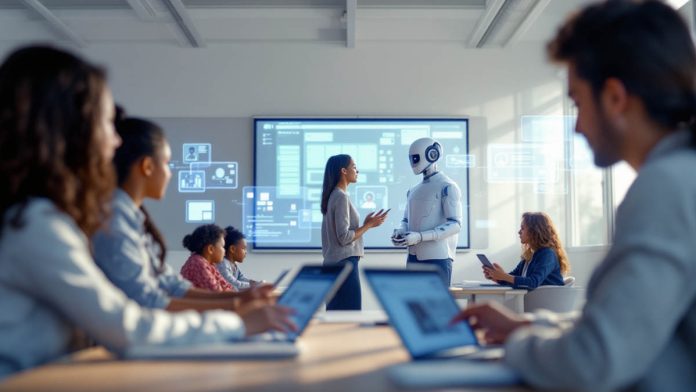The world of education is entering a new technological era, and this time artificial intelligence (AI) is leading the charge. On a warm Saturday in San Antonio, dozens of teachers swapped their weekend rest for an AI-powered workshop designed to show how intelligent systems can transform the classroom experience. What they discovered was both exciting and unsettling — from AI that instantly grades assignments to algorithms that convert lesson plans into podcasts or storybooks. Yet one question echoed among attendees: “Are we going to be replaced by AI?”
While that future remains uncertain, it’s clear that Big Tech companies are investing heavily to shape the next generation of educators and students. Microsoft, OpenAI, and Anthropic have teamed up with the American Federation of Teachers (AFT), offering millions of dollars to train educators on how to use AI tools effectively. This collaboration marks a rare partnership between teachers’ unions and tech giants — two groups that often clash — but now share a mission: preparing America’s future workforce.
Microsoft has pledged $12.5 million over five years, OpenAI is contributing $8 million plus $2 million in technical support, and Anthropic has added $500,000 to fund a new AI training hub in New York City. The AFT plans to use these funds to build virtual and physical workshops, with the goal of training 400,000 teachers in the next five years. Meanwhile, the National Education Association (NEA) has joined the movement with its own $325,000 partnership with Microsoft to develop AI microcredentials and online learning modules for educators nationwide.
This wave of private investment comes as the U.S. government actively promotes AI education. The Trump administration’s AI Education Task Force has encouraged partnerships between schools and tech companies to maintain the nation’s global leadership in artificial intelligence. Over 100 organizations have already joined the effort.
For Big Tech, education is not just philanthropy — it’s a strategic opportunity. Microsoft’s $4 billion AI initiative includes free access to CoPilot tools for schools in Washington State, while Google has announced a $1 billion commitment to provide its Gemini for Education platform to U.S. high schools. These initiatives could shape the tools, habits, and loyalties of tomorrow’s digital workforce.
Still, not everyone is convinced. Robin Lake, Director of the Center on Reinventing Public Education, cautions that educators must ensure that partnerships serve students first. “These are private initiatives run by companies with vested interests,” she warns. Similarly, Microsoft President Brad Smith advises teachers to remain cautiously optimistic, acknowledging the potential risks to critical thinking and student independence as AI becomes more deeply embedded in classrooms.
At ground level, however, teachers are beginning to see AI as an ally, not a threat. During the San Antonio workshop, educators explored tools like ChatGPT, Gemini, Microsoft CoPilot, Khanmingo, and Colorín Colorado. Some described the technology as “amazing,” highlighting how it can personalize education, save time, and bring creativity back to teaching. For example, a bilingual teacher used AI to create illustrated flashcards in English and Spanish, while another teacher generated custom storybooks that included students’ names as characters — all within minutes.
One participant summed it up best: “Once you use it, you can’t go back.” AI is no longer just a futuristic idea — it’s already redefining how lessons are taught, how teachers work, and how students learn. The challenge now is to ensure that this transformation enhances education rather than automates it.
Conclusion:
The rapid integration of AI into classrooms marks a turning point in modern education. With billions in funding and millions of teachers being trained, the partnership between Big Tech and educators could reshape learning for decades to come. Whether this evolution empowers teachers or diminishes their role will depend on how wisely the technology is implemented — and how steadfast educators remain in putting students first.





